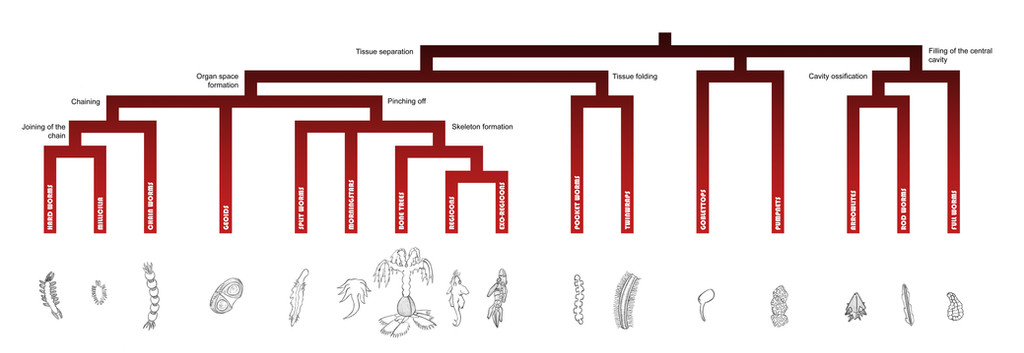HOME | DD
 Zerraspace — Zainterian Tree of Life - Solinozoa
Zerraspace — Zainterian Tree of Life - Solinozoa

Published: 2016-08-06 07:36:16 +0000 UTC; Views: 1901; Favourites: 11; Downloads: 18
Redirect to original
Description
When I started the Zainter project, I claimed there were 11 animal phyla, though I routinely joked that there were in fact forty or so in total, the remainder being minor worm-like things. Said comment can be considered largely true of animal life on Earth as well, though depending on how finely you slice it, there may be 30 to 60 such phyla. As such, I think I can consider the following an accomplishment.
You see, while mulling over this at some time, I decided to more closely examine how the various phyla were related, looking to Earthly phylogenetic trees for inspiration, at which point I became determined to create a similar effort of my own. There are now 27 phyla, split amongst two domains distinguished by their differing cellular characteristics. On Deviantart, I will be dealing with each of these separately.
What you are more familiar with are the Solinazoa, which evolved from an ancestor that was little more than a tube of cells. Surface cells developed ingrowths to allow for metabolizing oxygen, becoming the basis of their life without a mitochondrial analogue. They are the more diverse of the two domains, and their composite phyla can be listed as such:
- Hard Worms: organisms with a flexible keratin-based endoskeleton, divided into eight sections, generally with the first of these forming a designated head, the last a tail, and the remainder used for locomotion.
- Millicilia: close relatives of the hard worms, the millicilia have a very similar general anatomy, but lack the internal skeleton and set number and specialization of segments. They are universally small in size and tend towards planktonic roles.
- Chain Worms: organisms that gather behind one another to form chains linked mouth-to-back as part of their developmental cycle, passing digested meals throughout the entire gang for sustenance.
- Geoids: organisms in which the original skin layer is sloughed off and the underlying skeleton wraps around itself to enclose the remaining body. Geoids take their name from their shape, as they tend to form intricate geometric structures.
- Split Worms: organisms with an exposed digestive and respiratory tract due to pinching of the tubal embryo.
- Morningstar: muscular organisms with an inflatable hydraulic skeleton that allows them to revert between solid and flexible states when they need to exert pressure or slip through small spaces.
- Bone Trees: one of Zainter’s primary autotrophs, the bone trees developed from a crinoid-like ancestor that incorporated photosynthetic material from surrounding algae and became increasingly plant-like as a result, though some have reverted to a more active heterotrophic lifestyle.
- Regicons: organisms with a series of cage-like ribs that form an endoskeleton, they are extremely diverse on land but not so much in the water.
- Exo-Regicons: organisms with a dual skeleton, one external and one internal. While generally small or slow on land, they are one of the most diverse groups in the water and feature Zainter’s largest non-bone tree species.
- Pocket Worms: organisms in which fractal folding of the skin creates in-grown pockets that provide an extended surface area close to the central body mass for respiratory and digestive purposes.
- Twinwraps: organisms in which the original skin layer wraps around the inside of the developing tubal embryo. The similar composition means that twinwraps can be folded inside-out to nearly no effect.
- Goblettops: organisms that are little more than a filterfeeding tube attached by a stalk to an underwater substrate, the goblettops are probably the closest living organisms to the original Solinazoa.
- Pumpnets: sheet-like organisms that either take on the shape of their attached substrate, or invade bushmats to steal branchbuilders that will build them supportive skeletons.
- Arrowlites: organisms with a semi-flexible exoskeleton that move solely through vibrations of inner muscles conducted through their shells.
- Rodworms: organisms containing a nonflexible single-piece spine arising from ossification of the tubal embryo’s central cavity. Motion is achieved by undulation of their skin.
- Fullworms: organisms that are little more than a bag of cells, with the central cavity having transformed into a multi-cell layered filter that acts as a makeshift stomach. They are universally very small in size and tend towards planktonic roles.
For more information, please refer to the Zainter Project gallery, or go to the Speculative Evolution website, Remake of Zainter page here: s1.zetaboards.com/Conceptual_E…

























